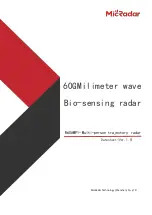
IntuVueRDR-7000 Weather Radar Pilot's Guide
Expanded Operating Instructions
D201911000094
18
Rev 0, Feb 2020
UNDERSTANDING THE DISPLAY IN WX ALL AND WX PATH
MODES
In WX ALL or WX PATH modes, the RDR-7000 projects a three-
dimensional memory space onto a two-dimensional display. This
means the weather displayed for any one memory cell is the color of
the strongest return in that column of memory cells. Specifically, if
there is any weather data in a given column that is inside the
envelope for OnPath weather; the color of the strongest of these
returns is displayed. If there is no weather data inside the envelope,
then the color of the strongest return from outside the envelope is
displayed as Off Path weather.
Stronger returns outside the envelope (Off Path weather) never
override the returns displayed as OnPath weather.
The nominal flight path weather envelope is ±4,000 feet with respect
to the expected flight path. These boundaries are expanded in areas
where convective activity is detected.
The upper boundary for the relevant weather envelope is never
less than:
10,000 feet OR
25,000 feet, if potentially hazardous convection is
detected.
and never greater than 60,761 feet.
The lower boundary of the relevant weather envelope is:
4,000feet below the altitude of the intended flight path of
the aircraft OR
At most 25,000feet, if potentially hazardous convection is
detected.
and never less than 0 feet.
The following figure shows the aircraft flight plan and the associated
flight path weather envelope. The black line graphs the aircraft
elevation at the waypoint distances from current position. The
shaded region is the relevant area generated from the elevation
graph. This area is rotated 360 degrees around the aircraft position
to produce the relevant weather envelope. Reflectivity outside the
scan area of the radar will eventually age to black if not refreshed.
The expanded envelope is associated with areas of potentially
hazardous convection (moderate or higher Vertical Integration of
Reflectivity).
















































